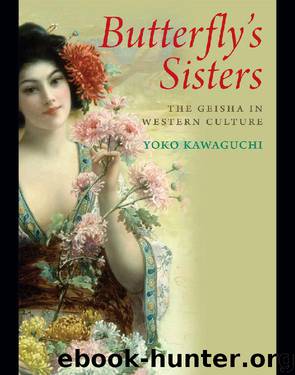Butterfly's Sisters by Yoko Kawaguchi

Author:Yoko Kawaguchi
Language: eng
Format: epub
ISBN: 978-0-300-11521-5
Publisher: Yale University Press
Sadayakko's emotionally expressive yet dispassionate dancing caught the imagination of three important contemporary western dancers: Loie Fuller, Isadora Duncan and Ruth St Denis. All three were innovators who created new styles of expressive dance which broke free of the conventions of traditional ballet. Loie Fuller, who took on the management of Sadayakko and Otojir's troupe,68 started out on her stage career as an ambitious, if somewhat mediocre, actress, but it was for her dance spectacles, in which she glided and whirled while deftly manipulating swirling yards of diaphanous cloth (held up from inside her costumes by means of long rods) that she became a celebrity in Paris during the 1890s. She created an uncanny, ethereal effect out of a play of fluid motion and perpetually shifting shapes, an effect enhanced by her clever use of electric lighting and rapid changes of coloured lights to accentuate ripples of light and shadow. Her famous dances, such as The Butterfly, La Danse du feu and La Danse du lys, were in accord with the aesthetics of the art nouveau movement in the visual arts, which drew inspiration from the ways in which living forms were depicted in Japanese decorative arts. Fuller, who was adroit at taking advantage of current cultural trends, professed a fascination with all things Japanese. However deep her actual interest in Japanese culture went, her style of dance reflected the artistic imagination of the fin-de-siècle period.
Isadora Duncan and Ruth St Denis both saw Sadayakko dance in Paris in 1900. Duncan was twenty-three, and had just arrived from London, where she had begun to establish herself as a dancer under the patronage of a circle of painters chiefly associated with the New Gallery in Regent Street, many of whom, like Lawrence Alma-Tadema, had striven to reinterpret on canvas the flavour of life in the classical world, a fascination with which Duncan shared and from which she drew a great deal of her inspiration. Not long after arriving in Paris, Duncan was being invited to dance at the best salons in the city. In January 1902, just as Fuller was about to set off from Paris for a continental tour with Sadayakko, Otojir and their troupe, she offered to take Duncan under her wing. Duncan was pleased to accept, and caught up with Fuller and the Japanese actors in Berlin. But in Vienna, the insubstantial costumes in which she danced caused a public outcry, and her insouciant attitude to the distinguished guests to whom Fuller wanted to show her off signalled her growing disdain for her would-be mentor's desire for control. Duncan abruptly turned her back on Fuller and struck off on her own for a triumphant appearance in Budapest.
While Fuller and Duncan found their creative home in Europe, Ruth St Denis helped create a fertile ground for the development of modern dance back in America. Not only did she herself tour extensively around the United States, but together with her husband Ted Shawn she founded the influential dance company Denishawn, which nurtured such young talent as Martha Graham.
Download
This site does not store any files on its server. We only index and link to content provided by other sites. Please contact the content providers to delete copyright contents if any and email us, we'll remove relevant links or contents immediately.
| African | Asian |
| Australian & Oceanian | Canadian |
| Caribbean & Latin American | European |
| Jewish | Middle Eastern |
| Russian | United States |
4 3 2 1: A Novel by Paul Auster(11047)
The handmaid's tale by Margaret Atwood(6852)
Giovanni's Room by James Baldwin(5877)
Big Magic: Creative Living Beyond Fear by Elizabeth Gilbert(4723)
Asking the Right Questions: A Guide to Critical Thinking by M. Neil Browne & Stuart M. Keeley(4574)
On Writing A Memoir of the Craft by Stephen King(4213)
Ego Is the Enemy by Ryan Holiday(3991)
Ken Follett - World without end by Ken Follett(3972)
The Body: A Guide for Occupants by Bill Bryson(3800)
Bluets by Maggie Nelson(3709)
Adulting by Kelly Williams Brown(3669)
Guilty Pleasures by Laurell K Hamilton(3586)
Eat That Frog! by Brian Tracy(3514)
White Noise - A Novel by Don DeLillo(3434)
The Poetry of Pablo Neruda by Pablo Neruda(3366)
Alive: The Story of the Andes Survivors by Piers Paul Read(3310)
The Bookshop by Penelope Fitzgerald(3225)
The Book of Joy by Dalai Lama(3217)
Fingerprints of the Gods by Graham Hancock(3212)
